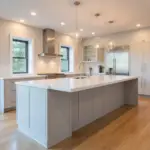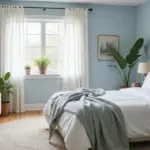Picture this: you’re standing at the threshold of your bedroom, paintbrush in hand, ready to transform your space into a tranquil oasis. The Arctic wind howls outside, but inside, you’re about to create a haven of peace. As an architect who’s spent countless nights under the dancing Northern Lights, I’ve learned a thing or two about crafting spaces that soothe the soul and quiet the mind.
Choosing calming bedroom colors isn’t just about aesthetics—it’s about creating an environment that nurtures your well-being. It’s a delicate balance of art and science, much like designing an eco-friendly home that harmonizes with the rugged Alaskan landscape. In this guide, we’ll explore the psychology behind calming hues and uncover how these colors can transform your bedroom into a sanctuary of tranquility.
Before we dive in, you might want to check out our comprehensive guide to choosing bedroom paint colors for a broader perspective. Now, let’s embark on a journey to create your perfect sleep environment.

The Psychology of Calming Colors
Just as the vast Alaskan tundra evokes a sense of peaceful solitude, certain colors have the power to instill tranquility in our living spaces. The psychology of color bridges the gap between our visual perceptions and emotional responses.
Understanding Color Psychology
Colors speak a language all their own, whispering to our subconscious and influencing our mood. Blue often conjures feelings of serenity, much like gazing at a clear sky reflected in a still lake. Red, on the other hand, can stir excitement or even anger, reminiscent of the fierce determination needed to survive in harsh Arctic conditions.
It’s crucial to recognize that color perception isn’t universal. Cultural differences play a significant role in how we interpret hues. In some cultures, white symbolizes purity, while in others, it’s associated with mourning. This diversity in perception reminds me of the varied landscapes across Alaska—each evoking different emotions in those who behold them.

Benefits of Calming Shades
Imagine returning home after a grueling expedition in the Alaskan wilderness. As you enter your bedroom, painted in soft, soothing tones, you feel the tension melt away. This isn’t just imagination—it’s backed by science.
Studies have shown that calming bedroom colors like soft blues and greens can significantly reduce stress and anxiety. These hues have been found to lower heart rates and blood pressure, creating a physiological state of relaxation. It’s akin to the calm that washes over you when you step into a grove of snow-laden pines or watch the gentle ebb and flow of the tide.
How Colors Affect Mood
The relationship between color and mood is as complex as the interplay of light and shadow on a fjord. Warm tones like yellow can evoke happiness, much like the first rays of the sun after a long winter. Cool tones such as teal promote calmness, reminiscent of the quiet moments spent watching the Aurora Borealis dance across the night sky.
But it’s not just about the hue—saturation and brightness play crucial roles too. Bright colors can energize a space, while muted shades offer comfort and ease, creating a cocoon-like atmosphere perfect for rest.

Blue Shades for Tranquility
In the vast expanse of the Alaskan wilderness, the sky and water paint a canvas of blue that stretches as far as the eye can see. It’s no wonder that blue is often associated with tranquility and peace.
Soft Blues for Relaxation
Soft blue tones, reminiscent of a clear summer sky or gentle waves, have an innate ability to soothe the soul. Research has shown that people with blue bedrooms tend to enjoy the longest average sleep per night compared to those with differently colored bedrooms.
When incorporating soft blues, consider using them on the walls or as accents in your bedding and decor. A light sky blue can create an expansive feeling, making your room feel larger and more open—a welcome effect during the long, dark Alaskan winters.
Deep Blues and Peace
While soft blues bring to mind clear skies, deep blues evoke the depths of the ocean or the star-studded night sky. These richer hues can create a sense of security and stability in your bedroom, much like the feeling of being sheltered in a cozy cabin while a storm rages outside.

To incorporate deep blues without overwhelming your space, consider using them as an accent wall or in your bedding. Pairing deep blue with lighter shades can create a balanced and visually interesting room that maintains its calming effect.
Pairing Blue with Neutrals
In the Alaskan landscape, the blue of the sky and water is often complemented by the neutral tones of rock, snow, and weathered wood. Similarly, combining blue with neutral tones can create a harmonious and soothing bedroom environment.
Pairing blue with warm neutrals like beige or soft gray can enhance the calming effect while adding depth and interest to your room. This combination creates a balance between cool and warm tones, much like the interplay of ice and sunlight in an Arctic landscape.
Green Tones for Serenity
In the heart of Alaska’s wilderness, the vibrant greens of summer foliage burst forth after long, white winters, bringing a sense of renewal and calm. This natural phenomenon serves as the perfect inspiration for incorporating green tones into your bedroom.

Light Greens and Calmness
Light green shades, reminiscent of fresh spring leaves or soft Arctic moss, can infuse your bedroom with a sense of tranquility and freshness. Research indicates that green can make people feel less stressed and more relaxed, similar to the effect of being in nature.
When using light greens, consider applying them to larger surfaces like walls or bedding. A soft sage or mint green can create a soothing backdrop that promotes relaxation and reduces stress. Try combining light green with natural textures like wood or woven fabrics to enhance the nature-inspired theme.
Nature-Inspired Green Hues
Deeper, nature-inspired green hues can evoke the lush forests of Southeast Alaska or the hardy vegetation of the tundra. These colors have a grounding effect, making spaces feel stable and connected to the earth.
To incorporate nature-inspired greens, consider using them in various elements of your room. A deep forest green accent wall can create a focal point, while accessories in shades of olive or moss can add depth and interest. Don’t forget to include actual plants in your decor—they not only reinforce the color scheme but also improve air quality and overall well-being.

Combining Green with Other Colors
Just as the Alaskan landscape offers a rich palette of greens complemented by other natural hues, your bedroom can benefit from thoughtful color combinations. Green pairs beautifully with earthy tones, creating a harmonious and natural look.
Try combining green with warm browns or soft beiges to evoke the feeling of a forest floor. For a more dynamic look, consider pairing green with muted yellows or deep blues—colors often found in natural settings like meadows or lakeshores.
For those interested in exploring bolder options while maintaining a calming atmosphere, our article on using bold bedroom paint colors offers some creative ideas that could complement your green palette.
Lavender’s Soothing Effects
As we venture further into our exploration of calming bedroom colors, let’s turn our attention to a hue that’s as soothing as the last light of an Alaskan summer evening—lavender.

Subtle Lavender for Restfulness
Lavender, with its soft and muted tones, has long been associated with relaxation and restfulness. It’s a color that whispers rather than shouts, making it an excellent choice for creating a peaceful bedroom environment.
Studies suggest that subtle lavender shades can significantly improve sleep quality and reduce anxiety. This makes it a powerful tool in our color palette for designing restful spaces.
To incorporate subtle lavender, consider using it on walls or in larger textile pieces like curtains or bedding. The key is to choose a muted shade that creates a soft, enveloping atmosphere without overwhelming the senses.
Complementary Colors with Lavender
While lavender is beautiful on its own, pairing it with complementary colors can enhance its calming effects and create a more dynamic space. Consider combining lavender with soft gray for an elegant look, white for a fresh and airy feel, or muted yellow for a touch of warmth.
When working with these color combinations, consider the 60-30-10 rule: use your main color (lavender) for about 60% of the room, a secondary color for 30%, and an accent color for the remaining 10%. This creates a balanced and visually pleasing space.

Other Calming Colors
While blue, green, and lavender often take center stage in discussions about calming bedroom colors, there’s a whole spectrum of soothing hues that can transform your space into a tranquil retreat.
Light Gray’s Clean Feel
In the misty mornings of an Alaskan fjord, light gray dominates the landscape, creating a sense of quiet and stillness. This same feeling can be brought into your bedroom through the use of light gray tones.
Light gray offers a clean, modern appeal while maintaining a calming atmosphere. It serves as an excellent neutral backdrop, allowing other elements in your room to shine. To incorporate light gray effectively, use it as a base color on walls or larger furniture pieces, and pair it with soft blues or greens for a nature-inspired palette.
Inviting Beige and Cream
Beige and cream tones bring to mind the soft, warm sands of coastal Alaska or the creamy foam atop a comforting latte. These colors create an inviting atmosphere that feels cozy and comforting.
What makes beige and cream so effective as calming bedroom colors is their versatility. They serve as excellent base colors, allowing for easy customization and adaptation to changing tastes or seasons. Use different shades to create depth and interest, and incorporate various textures to prevent the room from feeling flat.

Comforting Light Pink
Light pink, reminiscent of the soft hues of an Alaskan sunset, has a gentle, comforting nature that makes it an excellent choice for a calming bedroom color. This hue evokes feelings of warmth and care, creating a nurturing environment that can help reduce stress and promote relaxation.
To incorporate light pink effectively, use it as an accent color on one wall or in textiles like curtains or bedding. Pair it with light grays or whites to maintain a serene atmosphere, and add natural elements like plants or wooden furniture to balance the softness of pink.
Colors to Avoid in Bedrooms
Just as certain colors can promote relaxation and calmness, others can disrupt the tranquil atmosphere we’re striving to create in our bedrooms. Let’s explore some hues that might be better left out of your bedroom palette.
Overstimulating Bright Shades
Bright, vivid colors like electric blue, neon green, or hot pink can be as jarring as the sudden flash of the Northern Lights on a dark winter night. While beautiful, these intense hues can be overstimulating in a bedroom setting.
Research indicates that bright colors can increase energy levels and alertness, which is counterproductive when you’re trying to wind down for the night. If you’re drawn to bright colors, consider using them sparingly as accents.

Dark and Gloomy Tones
While the long, dark Alaskan winters can be beautiful, they’re not something we typically want to recreate in our bedrooms. Dark colors like deep purple, navy, or forest green can create an oppressive feeling, especially in smaller spaces or rooms with limited natural light.
If you love darker colors, consider using them as accents or on a single feature wall. Balance them with lighter tones to prevent the room from feeling too heavy or claustrophobic.
Impact of Bold Reds
Red is a color of passion and energy—think of the vibrant red of wild Alaskan berries or the fierce crimson of a sunset over the Chugach Mountains. While beautiful, bold reds can be problematic in a bedroom setting.
Studies have shown that exposure to the color red can increase heart rate and blood pressure. This physiological response can make it harder to relax and fall asleep. If you’re drawn to red, consider using softer, muted shades like terracotta or dusty rose.
Enhancing Bedroom Calmness
Creating a calming bedroom goes beyond just choosing the right colors. It’s about crafting an environment that nurtures relaxation and promotes restful sleep.
Natural Lighting Benefits
Natural light plays a vital role in regulating our circadian rhythms and enhancing our mood. It can make colors appear more vibrant and create a sense of openness in your bedroom. To maximize natural light, use sheer curtains or blinds that allow light to filter through, position mirrors strategically to reflect light around the room, and keep windows clean and unobstructed.

Importance of Decluttered Spaces
A tidy, organized space has a significant calming effect on our minds. Clutter can be a major sleep disruptor, leading to feelings of stress and anxiety. By decluttering, you create a sense of order and control in your environment, which can help reduce stress and improve focus.
Relaxing Decorative Elements
Carefully chosen decorative elements can enhance your bedroom’s calming atmosphere. Soft textiles and cushions add comfort and visual interest without cluttering the space. Natural elements like wood, stone, or plants can create a connection with nature, promoting relaxation and well-being.
Closing Thoughts
As we conclude our journey through the world of calming bedroom colors, I’m reminded of the serene beauty of an Alaskan twilight—soft, soothing, and infinitely peaceful. Creating a bedroom that embodies this tranquility is more than just a design choice; it’s an investment in your well-being.
We’ve explored a palette of calming bedroom colors, from tranquil blues to soothing greens, gentle lavenders, and clean neutrals. Each of these colors has the power to transform your bedroom into a serene sanctuary, a place where stress melts away and restful sleep comes easily.

Remember, the perfect bedroom color scheme is deeply personal. Take the time to explore different shades and combinations. Don’t be afraid to experiment until you find the palette that resonates with your soul and creates the calming atmosphere you desire.
As you embark on your bedroom transformation, keep in mind that color is just one element of a restful space. Natural light, decluttered surfaces, and thoughtfully chosen decor all play crucial roles in creating your ideal sleep environment.
So, pick up that paintbrush and let your walls become the canvas for your tranquil masterpiece. Create a space that welcomes you with open arms at the end of each day, a serene sanctuary that nurtures your well-being and invites sweet dreams.
Here’s to peaceful nights and rejuvenating mornings in your newly calming bedroom. May it be as serene and inspiring as the beautiful Alaskan wilderness that surrounds us.
For more inspiration on current color trends, don’t forget to check out our article on bedroom color trends for 2024.






